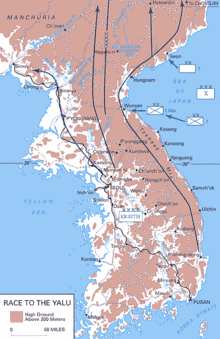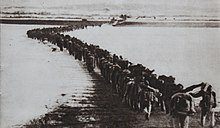Battle of Chongju (1950)
| Battle of Chongju (1950) | |
|---|---|
| Part of the Chongju , North Korea | |
| Result | United Nations victory |
30 wounded
10 captured
11 tanks
2 self-propelled guns
The Battle of Chongju (
That evening the KPA were strongly reinforced, attacking the Australian southern flank manned by D Company 3 RAR, and partially penetrating their perimeter. After two hours of fighting the assault was repulsed, and the KPA subsequently launched a furious assault against A Company 3 RAR on the northern position, which also failed amid heavy losses. The following day the Australians advanced to the high ground overlooking Chongju, killing and capturing a number of KPA in skirmishes. That afternoon the town itself was cleared by the remaining elements of the
Background
Military situation
The

Australia was one of the first nations to commit units to the fighting, playing a small but sometimes significant part in the UN forces, which was initially led by
On 23 September 1950, 3 RAR embarked for Korea, concentrating at Pusan on 28 September. There it joined the British
Prelude
Opposing forces

By the time 3 RAR arrived in the theatre, the KPA had been broken and were in rapid retreat, with MacArthur's forces conducting a successful
The 27th British Commonwealth Brigade subsequently moved 70 kilometres (43 mi) from Kumchon, with the Argylls
On the afternoon of 25 October a platoon from 3 RAR was fired on by two companies of KPA as they crossed the
Battle
Fighting around Chongju, 29 October 1950
3 RAR took over as lead battalion of the 27th British Commonwealth Brigade on 29 October, 6 kilometres (3.7 mi) from Chongju. At 10:00 a
At 14:30, D Company launched an assault against the ridge south of the road, with two platoons of Sherman tanks in support from D Company, US 89th Tank Battalion. One tank platoon led the attack followed by the other carrying infantry from 10 Platoon D Company. Under the command of Lieutenant David Mannett, 10 Platoon made a right flanking assault along the road, while 11 and 12 Platoons attacked the ridge frontally across the paddy fields.

A Company attacked the ridgeline to the north of the road to Chonju just prior to dusk, this time without the support of the Sherman tanks.[27] The Australians again came under heavy fire from the KPA, however they quickly overcame the defenders and the ridge was secured by 17:30.[18] During the fighting for the northern position, three KPA T-34 tanks dug-in on the ridgeline had been destroyed by the Australians at short range with M20 3.5-inch bazookas, which now proved to be effective anti-armour weapons despite difficulties experienced in their use at Kujin several days before.[28] During the day's fighting, a total of 11 T-34 tanks and two SU-76 self-propelled guns had been destroyed by the Australian infantry and American tanks, contrary to the reports of their destruction by USAF airstrikes earlier in the day.[23] Expecting a counter-attack, Green then ordered B Company forward to occupy positions along the road in between the positions held by D and A Companies, while Battalion headquarters moved in behind B Company, with C Company held in reserve at the rear with Support Company. After conducting a limited resupply of the forward companies, the Australians hastily began to dig in.[31]
The KPA subsequently brought up substantial reinforcements, and soon after dark they moved against D Company on the southern flank.[31] Preparatory fire by artillery, mortars and machine-guns began at 19:00, following which a battalion-sized ground assault was launched.[32] The weight of the counter-attack fell on 10 Platoon D Company, with Mannett holding his platoon's fire until the KPA were only 10 metres (33 ft) away before engaging, killing 32 men. Mannett was later awarded the Military Cross for his leadership during the initial assault and the subsequent defence of the ridgeline.[26][33] Regardless, the KPA succeeded in overrunning parts of the Australian position before they were finally repulsed following counter-attacks by 11 and 12 Platoons during two hours of fierce fighting.[22] A number of KPA also succeeded in penetrating the perimeter, and they moved behind D Company from where they fired on the 3 RAR headquarters. Contact was subsequently lost with D Company and was not regained until the KPA were forced to withdraw by Headquarters Company, under Captain Ben O'Dowd, which then cleared the depth positions.[32] At 21:30 the focus of the KPA counter-attack shifted to the northern flank, launching a heavy assault against A Company. This effort also failed however, being repulsed as Chitts called-in indirect fire from the Support Company mortars and American howitzers to within 10 metres (33 ft) of the forward Australian positions.[34] The KPA finally withdrew at 22:15, though a SU-76 self-propelled gun continued to fire sporadically into the Australian positions until 23:00.[31]
Clearance of the town, 30 October 1950
The following morning the Australians remained in position, and at daybreak they found more than 150 KPA dead within the 3 RAR defensive position.[31] Coad subsequently brought the Middlesex forward to secure his northern flank, while 3 RAR moved forward to the Talchon River, taking up positions in the hills overlooking Chongju by 11:00. During the advance the Australians had clashed with a number of KPA stragglers, killing 12 and capturing 10 in skirmishes. It became clear that organised resistance had ceased however, with the successful Australian assault and the subsequent defence of its objectives the day before breaking the KPA locally.[35] In the north the Middlesex pushed forward to the riverbank, while in the afternoon the Argylls forded the river with two platoons of Shermans. Meanwhile, aerial reconnaissance reported the presence of KPA tanks to the west of Chongju.[35] Regardless, that afternoon the Argylls encountered no further opposition as they entered and cleared the ruined and burning town, securing it by 17:00.[36] The brigade then moved into divisional reserve for the US 24th Infantry Division, with Church ordering the US 21st Infantry Regiment to take its place in the lead in order to give the British and Australian infantry a much needed respite.[34] The tanks and infantry of the 21st Infantry Regiment subsequently moved through the brigade.[35]
The 27th British Commonwealth Brigade adopted tight security that evening due to the threat of KPA infiltration.
Aftermath
Casualties

The fighting around Chongju was the heaviest undertaken by the Australians since entering the war.
Subsequent operations
During the last weeks of October the Chinese had moved 18 divisions of the
Notes
Footnotes
- ^ Among the KPA dead was the commanding officer of the Reconnaissance Unit of the 17th Tank Brigade, Lieutenant Colonel Kim In-sik, who was carrying a number of marked maps and documents. See O'Neill 1985, p. 44.
- Pusan, along with 281 other Australian casualties. See Barter 1996, pp. 313–314.
Citations
- ^ MacDonald 1986, p. 30.
- ^ Dennis et al 2008, pp. 300–302.
- ^ MacDonald 1986, p. 39.
- ^ MacDonald 1986, pp. 39–40.
- ^ Johnston 2003, p. 55.
- ^ O'Neill 1985, p. 706.
- ^ a b Dennis et al 2008, p. 302.
- ^ O'Dowd 2000, p. 3.
- ^ a b Breen 1992, p. 8.
- ^ Horner 2008, p. 57.
- ^ Farrar-Hockley 1990, p. 239.
- ^ Horner 2008, p. 58.
- ^ Horner 2008, pp. 58–61.
- ^ Coulthard-Clark 2001, p. 257.
- ^ Gallaway 1999, p. 67.
- ^ Farrar-Hockley 1990, p. 248.
- ^ Coulthard-Clark 2001, p. 258.
- ^ a b c d e Coulthard-Clark 2001, p. 259.
- ^ a b c Horner 2008, p. 62.
- ^ O'Neill 1985, pp. 44–46.
- ^ Farrar-Hockley 1990, pp. 256–257.
- ^ a b c Odgers 2009, p. 48.
- ^ a b O'Dowd 2000, p. 14.
- ^ Gallaway 1999, pp. 91–92.
- ^ Farrar-Hockley 1990, p. 258.
- ^ a b O'Neill 1985, p. 48.
- ^ a b Gallaway 1999, p. 92.
- ^ a b O'Neill 1985, p. 49.
- ^ "Chongju – 29 October 1950". Out in the Cold: Australia's Involvement in the Korean War. Australian War Memorial. 2009. Archived from the original on 4 July 2009. Retrieved 18 August 2009.
- ^ "No. 39265". The London Gazette (Supplement). 19 June 1951. p. 3411.
- ^ a b c d e Coulthard-Clark 2001, p. 260.
- ^ a b Gallaway 1999, p. 94.
- ^ "No. 39205". The London Gazette. 17 April 1951. p. 2186.
- ^ a b c d Horner 2008, p. 63.
- ^ a b c Farrar-Hockley 1990, p. 260.
- ^ Bartlett 1960, p. 35.
- ^ a b Farrar-Hockley 1990, p. 261.
- ^ Gallaway 1999, pp. 96–97.
- ^ Barter 1996, pp. 313–314
- ^ O'Neill 1985, p. 51.
- ^ Horner 1990, pp. 438–439.
- ^ O'Neill 1985, p. 50.
- ^ O'Neill 1985, pp. 55–56.
- ^ Chinese Military Science Academy 2000, p. 90.
- ^ Fehrenbach 2000, p. 196.
- ^ Breen 1992, p. 9.
- ^ Roe 2000, p. 176.
References
- Barter, Margaret (1996). "Green, Charles Hercules (1919–1950)". Australian Dictionary of Biography. Vol. 14. Melbourne: Melbourne University Press. pp. 313–314. ISBN 0-522-84717-X.
- Bartlett, Norman, ed. (1960). With the Australians in Korea (Third ed.). Canberra, Australian Capital Territory: Australian War Memorial. OCLC 488462542.
- Breen, Bob (1992). The Battle of Kapyong: 3rd Battalion, the Royal Australian Regiment, Korea 23–24 April 1951. Georges Heights, New South Wales: Headquarters Training Command. ISBN 0-642-18222-1.
- Chinese Military Science Academy (2000). History of War to Resist America and Aid Korea (抗美援朝战争史) (in Chinese). Vol. II. Beijing: Chinese Military Science Academy Publishing House. ISBN 7-80137-390-1.
- Coulthard-Clark, Chris (2001). The Encyclopaedia of Australia's Battles (Second ed.). St Leonards, New South Wales: Allen & Unwin. ISBN 1-86508-634-7.
- Dennis, Peter; Grey, Jeffrey; Morris, Ewan; Prior, Robin; Bou, Jean (2008). The Oxford Companion to Australian Military History (Second ed.). Melbourne, Victoria: Oxford University Press. ISBN 978-0-19-551784-2.
- ISBN 0-11-630953-9.
- ISBN 1-57488-259-7.
- Gallaway, Jack (1999). The Last Call of the Bugle: The Long Road to Kapyong (Second ed.). St Lucia, Queensland: University of Queensland Press. ISBN 0-7022-3106-1.
- ISBN 0-04-442227-X.
- Horner, David, ed. (2008). Duty First: A History of the Royal Australian Regiment (Second ed.). Crows Nest, New South Wales: Allen & Unwin. ISBN 978-1-74175-374-5.
- Johnston, William (2003). A War of Patrols: Canadian Army Operations in Korea. Vancouver, British Columbia: UBC Press. ISBN 0-7748-1008-4.
- Kuring, Ian (2004). Redcoats to Cams: A History of Australian Infantry 1788–2001. Loftus, New South Wales: Australian Military Historical Publications. ISBN 1-876439-99-8.
- MacDonald, Callum A. (1986). Korea: The War Before Vietnam. New York City, New York: Free Press. ISBN 0-02-919621-3.
- ISBN 978-1-74110-807-1.
- O'Dowd, Ben (2000). In Valiant Company: Diggers in Battle – Korea, 1950–51. St Lucia, Queensland: University of Queensland Press. ISBN 0-7022-3146-0.
- ISBN 0-642-04330-2.
- Roe, Patrick C. (2000). The Dragon Strikes. Novato, California: Presidio. ISBN 0-89141-703-6.
Further reading
- Forbes, Cameron (2010). The Korean War: Australia in the Giants' Playground. Sydney, New South Wales: Macmillan. ISBN 978-1-405040-01-3.
- Pears, Maurie (2007). Battlefield Korea: The Korean Battle Honours of the Royal Australian Regiment, 1950–1953. Loftus, New South Wales: Australian Military History Publications. ISBN 9780980379600.
External links
